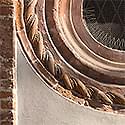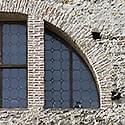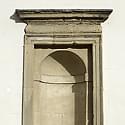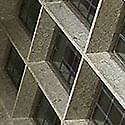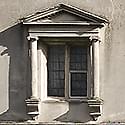
tabernacle frame, a substantial or distinguished surround to a window, emblematic of prestige [Latin: tabernaculum, a tent; diminutive form of taberna, shed, booth, shop constructed of boards].
In spheres other than architecture the word enjoys a number of shades of meaning — in Jewish history a curtained tent containing the Ark of the Covenant; in Christian history a canopied structure as a tomb or shrine; or the chapels or places of worship of Protestant non–conformists; and in the art world any kind of picture frame that resembles a building. The more common alternative is aedicule (which see).
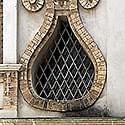
teardrop window/vent, a type of opening possibly unique to this gateway into the Northern Italian town of Crema.
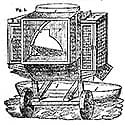
thermantidote, a rotating fan fixed in a window opening, fitted with tatties (wetted screens of woven fragrant cus–cus grass), used in India to drive a current of cooled air into homes, hospitals, and barracks.
In a country where temperatures could reach 44℃ for lengthy periods such devices were necessary to the health of non–Indians. ‘The weather is becoming very hot’ wrote Fanny Parkes, wife of a British army officer, ‘and we hope to feel cool by the aid of a thermantidote, for which we are building a terrace and verandah’. This was in March 1832. ‘It is an enormous machine . . . made of mango wood; the wheels and axle are of iron. In height, it is about seven feet, in breadth four or five, and some nine or ten or twelve feet in length . . . four large fans are turned round by two men on the outside; by which means the fans revolve and force air . . . into the house. The thermantidote, which is hollow and of circular form, has a projecting funnel, which is put through and fixed into the window of the house, from the machine which stands on the verandah’. The air was forced through screens of fibrous jungle grass (with a ‘fragrant, delicious and refreshing scent’) worked into bamboo frames that were made to fit exactly into the thermantidote, or into windows. She describes the wetting of the screens by a team of coolies ‘constantly employed’ in handing up water to fill a trough in the machine. That the apparatus was initially effective is clear from her diary entry for May — ‘for the first time I have been laid up with a strong attack of rheumatism and lumbago . . . and was told by a ‘medical man’ that “the thermantidote pours forth such a volume of cold air that if you have fallen asleep near it, it has caused all these aches and pains”. A month later she records ‘today the heat is dreadful; 89° [32℃] even at the mouth of the thermantidote, and in other parts of the house six degrees higher!
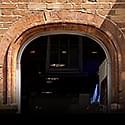
three–centred arch, an arch having side arcs on the springing line, joined by an upper arc below the springing line.
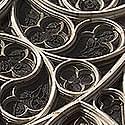
tracery, the subdivision of a window into lights shaped by stone mullions, straight and curved, in a variety of overall patterns, usually within a pointed–arched opening.

transparency, the quality of allowing the passage of light and clear vision.
The slow development of glass technology from the reign of Charles II and through the reigns of three Georges, combined with heavy taxation on this article, created the classic Georgian window — a gridiron of wooden bars blocking out daylight in varying degrees. Our familiarity with this article blinds us to the fact that it was not necessarily what people wanted, nor was it what architects wanted. Isaac Ware, writing in his A Complete Body of Architecture (1756) complains that ‘those thick bars we used to employ hurt the eye, and obstructed a great deal of light; they made a large window resemble a number of little ones: the intent is, that as much glass should be seen, and as nearly in a continued body as possible’.
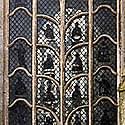
Tree of Jesse window, a depiction in tracery, or in stained glass, of a schematic genealogy of the ancestors of Christ.
The earliest examples, in the form of illuminated manuscripts, date from the 11th century. The ‘tree’ or ‘vine’ theme is also celebrated in stone carvings, embroideries and ivories. This window, from Dorchester Abbey, Oxfordshire, is a tour–de–force of delicate sinuous vine–like delicacy in stone, left plain on the outside and carved on the inside.
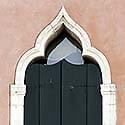
trefoil arch, having three lobes or leaves separated by cusps.
This is a pointed trefoil arch, and being an example from Venice, has an ogee termination.
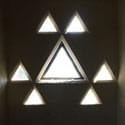
triangular window, a type not commonly encountered, having three sides rather than the more usual four.
Built by Sir Thomas Tresham between 1593 and 1597 within his own estate at Rushton, Northamptonshire, the Triangular Lodge is a three–floored structure on a triangular plan, each of the sides being thirty–three feet long. All three faces have three gables, below which are windows formed from trefoil–bordered groups of small triangular lights. Tresham, a recusant Roman Catholic, had been imprisoned and heavily fined for his adherence to the Catholic faith at a time when Queen Elizabeth I feared both a Spanish invasion, and insurrection by potential ‘traitors to the Crown’, followers of her Catholic cousin, Mary Queen of Scots. The number three is contained within Tresham’s name itself [Italian: tre, three], and its repetition in so many of the physical attributes of the Lodge symbolises the Holy Trinity. It is often said that the Elizabethans loved puzzles and secret codes, which could be taken to suggest that the Lodge was a defiant declaration of faith intended to be understood by only a few, but the symbolism here could not have been clearer had it been displayed in neon. Somewhat recklessly, Tresham’s son Francis, in attempting to further the Catholic cause, allowed himself to become involved in the failed 1605 Gunpowder Plot to blow up the House of Commons at the State Opening of Parliament, the intention being to kill the Protestant but relatively tolerant King James I. (Some time after his interrogation and confession, Francis Tresham died of natural causes in the Tower of London attended by his doctor; later his head was separated from his body and displayed, along with the heads of his co–conspirators, in Northampton, while his body was thrown into a pit in Tower Hill).
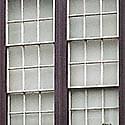
triple–hung sash, a window normally consisting of three counterbalanced sashes.
In this case a pair of triple–hung mullioned sashes.
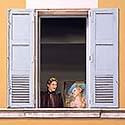
trompe l’oeil, the representation, on a flat surface, of apparently three-dimensional subject matter.
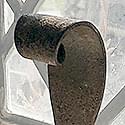
tulip leaf handle, a simple curved iron handle fixed to a metal casement.
A hole is sometimes provided in the base of the handle to accommodate the end of a hook stay.
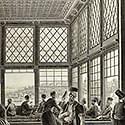
Turkish sashes, sash windows of European type, occurring throughout the Ottoman Empire.
How to determine the date of this Turkish coffee house? — and how does it come to have sash windows, found generally only in France, or Britain and its dominions and colonies? The stylistic detailing of the interior, particularly s– and c–shaped scrolls suggests a date from 1730 onward, the ‘Tulip Period’ of Ottoman architecture, derived from Iranian sources and corresponding roughly with the French Rococo period. It is significant that the first Turkish ambassador to France had returned from Paris a few years earlier. The historian Doğan Kuban, in Osmanli Mimarisi, 2007, states that ‘all the developments in Turkey in engineering and architecture may be said to have sprung from French roots’ — the new Christian and Turkish bourgeoisie of Istanbul having created a new francophone and Francophile culture. This was largely based on geopolitically–based hostility between the Ottoman Empire and the Habsburg Empire. We may be led to conclude, considering the comparative slenderness of what must be structural mullions rather than hollow sash boxes, that the sashes are of the French type, i.e. without counter–weights [See Note 7, French Sashes]. The engraving comes from the Voyage Pittoresque de Constantinople et des Rives du Bosphore, by Antoine Ignace Melling 1763–1831, architect and painter, who would have recorded this scene during his residence in Istanbul between 1782 and 1802. Other aspects of the illustration, Ottoman clothing and vessels seen in the distance, appear to be consistent with this date. We see enormous fixed top sashes with diagonally disposed panes over lying–pane glazed lower sashes, which can only have been lifted manually and held temporarily in position by pegs or ratchet devices. The lower sashes appear to pass through the heavy transom and sit on the outside of the upper sash, a feature unknown in France or Britain. The artist was an architect and painter employed by the ruler of the time and is known for the accuracy of detail in his work. However, on his return to Paris, the preparation of the Voyage Pittoresque by Parisian engravers took place over a number of years. Is it possible that error might have crept in? The process of deliberate Westernisation of the Ottoman Empire took place at this time also, and the work of European architects in collaboration with Turkish craftsmen and builders can be seen in the many sash–windowed palaces and government buildings in Istanbul and other major cities in Turkey.
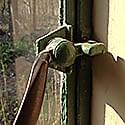
two–stage locking latch, a type of casement fastener allowing a window to be locked in a slightly open position in order to permit the passage of air while at the same time providing a small element of security.
In the window shown the top–hung night vent at the top and the side–hung casement are each provided with peg–stays, while the casement additionally has a two–stage locking latch.
tympanum, the face contained within the horizontal and raking cornices, or the horizontal and curved segmental cornices, of a pediment.



